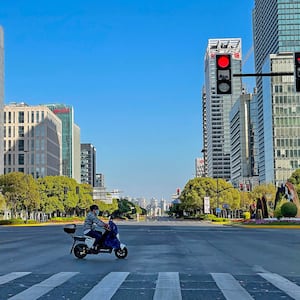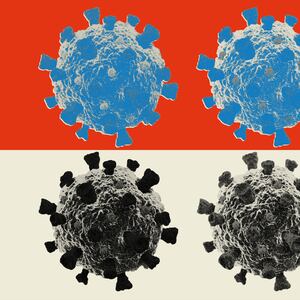After three years of strict COVID lockdown, many Chinese have had enough. Protests have erupted in cities across the country: Beijing, Hong Kong, Jinan, Kunming, Shanghai—the list goes on. Now some mayors—who national leaders have authorized to set local rules on crowds, business capacity, travel, mask-wearing and testing—are easing up on some COVID-related restrictions.
While many Chinese might welcome a return to something more closely resembling normal, experts warn there could be a cost. China’s so-called COVID Zero approach to the pandemic has probably saved millions of lives. Just 16,000 Chinese have died of COVID since 2019, an infinitesimal death rate in a country of 1.4 billion. But COVID Zero has also created the conditions for a temporary—but potentially devastating—surge in infections once restrictions end.
That’s because, after three years of frequent and strict lockdowns, China’s population doesn’t have a lot of natural antibodies from past infection. These are the best antibodies, and without them, the novel coronavirus might encounter precious little resistance if 1.4 billion Chinese start packing restaurants, entertainment venues, buses and trains.
The virus could surge through the population until enough people catch and survive COVID, and build up natural antibodies to block the easiest transmission pathways. Widespread natural antibodies, combined with the less protective and durable antibodies from vaccines, should eventually result in a fragile—but hopefully sustainable—sort of endemicity, like we’re already seeing in much of the world. The critical question is how much worse things would get before they got better.
Chinese authorities were already registering record numbers of COVID infections—around 30,000 daily new cases—when the protests began. Expect new records if more mayors cave. “We’re likely to see a spike in severe COVID-19 cases in China with the lifting of COVID Zero restrictions,” Eric Bortz, a University of Alaska-Anchorage virologist and public health expert, told The Daily Beast. “The hospitalization and death rates, particularly among the elderly, could be catastrophic.”
The rest of the world earned its natural antibodies by gradually lifting COVID restrictions while also encouraging, or even mandating, vaccination. The vaccines blunted the worst outcomes of mass infection, preventing the collapse of local health systems and buying time for natural immunity to build.
The record global surge in infections from the Omicron variant, starting a little over a year ago, was an inflection point for many countries. Coming months after good vaccines were widely available, the Omicron surge seeded natural immunity across a huge swathe of the world’s population—without also killing a huge swathe of the world’s population.

Protesters march along a street during a rally for the victims of a deadly fire as well as a protest against China's harsh Covid-19 restrictions in Beijing on Nov. 28, 2022.
Noel Celis/AFP via Getty ImagesRobust natural immunity can be self-replenishing. You catch and survive COVID, enjoy many months of strong protection from natural antibodies, then eventually catch COVID again as those antibodies start to fade. But lingering protection makes serious illness unlikely. So you feel sick for a few days and, as a consolation, get another six or nine months of strong natural immunity. So on and so forth, forever—unless and until the novel coronavirus abruptly mutates in dangerous new ways.
It’s a tenuous cycle, but a potentially beneficial one once you settle into it. The problem for the Chinese is that the overwhelming majority of them haven’t yet started the cycle. China, still locked down by COVID Zero, didn’t experience a big Omicron surge when most of the rest of the world did—and didn’t get all that natural immunity as a reward for enduring the surge.
No, China’s about to experience its Omicron surge now, a year late. “China is in an impossible position,” Lawrence Gostin, a Georgetown University global health expert, told The Daily Beast. “Trying to stop the Omicron variant from spreading is like putting a finger in the dyke as a tsunami is coming.”
How bad it gets could depend on a number of factors. How many mayors respond to local protests by lifting restrictions, and how much they lift restrictions. How everyday people respond in the weeks after their cities begin reopening. How well the Chinese COVID vaccines have held up, nearly two years after the first jab. And how quickly authorities can administer vaccine boosters to the most vulnerable segment of the Chinese population, the elderly. Gostin said he expects “tens of thousands of cases in the near future and millions of infections over time.”
If there’s good news, it’s that a spike in COVID in China shouldn’t lead to an increase in cases in countries around China. After all, no other country has locked down for three years, like China has. Everywhere but China, populations enjoy robust natural immunity. “Those countries are already living with the virus in their communities,” Ben Cowling, a professor of epidemiology at the University of Hong Kong, told the Daily Beast.
That said, any local surge in infections does come with risk for the wider human population, as every viral transmission is an opportunity for the virus to mutate into a more dangerous new form.
Part of the problem for the Chinese in particular, Gostin explained, is that the best Chinese vaccines are not as effective as the best Western vaccines. China’s most popular vaccines, Sinopharm and CoronaVac, are both conventional formulations with inactivated SARS-CoV-2 virus as their main ingredient. Both were around 75 percent effective when first administered, compared to 90 percent or better for the leading messenger-RNA vaccines that many other countries administer.
Sinopharm and CoronaVac were of middling effectiveness nearly two years ago. They could be much less effective now for someone who was near the front of the line for the jabs back in early 2021. Potentially hundreds of millions of fully vaccinated Chinese likely have very little protection today.

A medical worker checks a citizen's health QR code at the entrance of Guangzhou No.12 People's Hospital on Dec. 3, 2022 in Guangzhou, Guangdong Province of China.
Chen Jimin/China News Service via Getty ImagesBoosters should help. But where 9 out of 10 Chinese got their prime jabs, just half have gotten boosted with a third shot. And in contrast to many Western countries, where older people get vaccinated at higher rates, in China it’s the opposite. The older you are, the less likely you are to be vaccinated or boosted—a phenomenon experts attribute to rampant disinformation among elderly Chinese. Two-thirds of Chinese over 60 have gotten their booster. But as of this summer, only around 1 in 5 Chinese over the age of 80 was boosted. They could be most at risk as protests spread and Chinese cities reopen.
Authorities know a crisis is brewing. On Tuesday, China’s National Health Commission announced a new information campaign promoting vaccination among the elderly, as well as new rules shortening the time between prime vaccination and boosting for older patients. “It is also the hope that our elderly friends, especially those over 80, will take the initiative and get vaccinated for their personal health protection,” Xia Gang, an NHC official, told Reuters.
Paul Anantharajah Tambyah, president of the Asia Pacific Society of Clinical Microbiology and Infection in Singapore, told The Daily Beast he’s optimistic. “Vaccination can be ramped up very quickly,” he said. Ideally, cities will delay lifting the biggest restrictions until after authorities conduct a local vaccination drive.
The consequence, if they don’t, could be a tragic spike in serious illness and deaths—especially among the elderly. “The expected next step would be citywide lockdowns in cities with larger numbers of cases,” Cowling said.
But that’s COVID Zero, the reason for all these protests. If officials restore restrictions in order to prevent infections from the relaxed restrictions that the local populace demanded, they’ll just prolong the crisis. China needs natural immunity. And natural immunity begins with infections.








